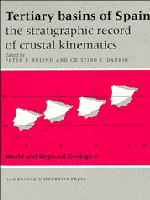Book contents
- Frontmatter
- Contents
- List of contributors
- Preface
- Dedication to Professor Oriol Riba IArderiu
- Memorial, Etienne Moissenet 1941–1994
- PART G GENERAL
- PART E EAST
- E1 Geological setting of the Tertiary basins of Northeast Spain
- E2 The lithosphere of the Valencia Trough: a brief review
- E3 Depositional sequences in the Gulf of Valencia Tertiary basin
- E4 Neogene basins in the Eastern Iberian Range
- E5 The Tertiary of the Iberian margin of the Ebro basin: sequence stratigraphy
- E6 The Tertiary of the Iberian margin of the Ebro basin: paleogeography and tectonic control
- E7 Stratigraphy of Paleogene deposits in the SE margin of the Catalan basin (St. Feliu de Codines – St. Llorenç del Munt sector, NE Ebro basin)
- E8 Onshore Neogene record in NE Spain: Vallès–Penedès and El Camp half-grabens (NW Mediterranean)
- E9 The Paleogene basin of the Eastern Pyrenees
- E10 The Neogene Cerdanya and Seu d'Urgell intramontane basins (Eastern Pyrenees)
- E11 Eocene-Oligocene thrusting and basin configuration in the eastern and central Pyrenees (Spain)
- E12 The Late Eocene–Early Oligocene deposits of the NE Ebro Basin, West of the Segre River
- E13 Chronology of Eocene foreland basin evolution along the western oblique margin of the South–Central Pyrenees
- E14 Evolution of the Jaca piggyback basin and emergence of the External Sierra, southern Pyrenees
- E15 Long-lived fluvial palaeovalleys sited on structural lineaments in the Tertiary of the Spanish Pyrenees
- E16 Evolution of the central part of the northern Ebro basin margin, as indicated by its Tertiary fluvial sedimentary infill
- E17 The Rioja Area (westernmost Ebro basin): a ramp valley with neighbouring piggybacks
- PART W WEST
- PART C CENTRE
- PART S SOUTH
- Index
E5 - The Tertiary of the Iberian margin of the Ebro basin: sequence stratigraphy
Published online by Cambridge University Press: 04 August 2010
- Frontmatter
- Contents
- List of contributors
- Preface
- Dedication to Professor Oriol Riba IArderiu
- Memorial, Etienne Moissenet 1941–1994
- PART G GENERAL
- PART E EAST
- E1 Geological setting of the Tertiary basins of Northeast Spain
- E2 The lithosphere of the Valencia Trough: a brief review
- E3 Depositional sequences in the Gulf of Valencia Tertiary basin
- E4 Neogene basins in the Eastern Iberian Range
- E5 The Tertiary of the Iberian margin of the Ebro basin: sequence stratigraphy
- E6 The Tertiary of the Iberian margin of the Ebro basin: paleogeography and tectonic control
- E7 Stratigraphy of Paleogene deposits in the SE margin of the Catalan basin (St. Feliu de Codines – St. Llorenç del Munt sector, NE Ebro basin)
- E8 Onshore Neogene record in NE Spain: Vallès–Penedès and El Camp half-grabens (NW Mediterranean)
- E9 The Paleogene basin of the Eastern Pyrenees
- E10 The Neogene Cerdanya and Seu d'Urgell intramontane basins (Eastern Pyrenees)
- E11 Eocene-Oligocene thrusting and basin configuration in the eastern and central Pyrenees (Spain)
- E12 The Late Eocene–Early Oligocene deposits of the NE Ebro Basin, West of the Segre River
- E13 Chronology of Eocene foreland basin evolution along the western oblique margin of the South–Central Pyrenees
- E14 Evolution of the Jaca piggyback basin and emergence of the External Sierra, southern Pyrenees
- E15 Long-lived fluvial palaeovalleys sited on structural lineaments in the Tertiary of the Spanish Pyrenees
- E16 Evolution of the central part of the northern Ebro basin margin, as indicated by its Tertiary fluvial sedimentary infill
- E17 The Rioja Area (westernmost Ebro basin): a ramp valley with neighbouring piggybacks
- PART W WEST
- PART C CENTRE
- PART S SOUTH
- Index
Summary
Abstract
The general definition and recognition criteria of ‘tectosedimentary units’ (TSUs) are described and discussed. The nonmarine sediments of the Iberian margin of the Ebro basin are divided into tecto-sedimentary units. Eight of these units (labelled T1 to T8) are described from the area; their ages range from Thanetian (Late Paleocene) to Turolian (Late Miocene).
Introduction
The Tertiary sediments of the Iberian margin of the Ebro basin were deposited in alluvial and lacustrine systems and mostly derived from this same margin. In these continental sediments detrital-clastic and evaporitic facies dominate, so there is a scarcity of fossiliferous beds, and chronostratigraphic and correlation studies using fossils are very difficult.
In contrast to the classical methods of stratigraphy, present methods of basin analysis are often concerned with the division of the basin-fill into ‘genetic units’. These units are defined by objective criteria that result from events that are thought to have affected the whole basin (Vera, 1989). We have followed this approach in our study of the southern margin of the Ebro basin using the ‘tectosedimentary analysis’ of Garrido-Megias (1973, 1982). This method is based on analysis of sequence evolution and the large-scale geometry of sedimentary bodies and results in the division of the basinfill into tectosedimentary units (TSUs).
- Type
- Chapter
- Information
- Tertiary Basins of SpainThe Stratigraphic Record of Crustal Kinematics, pp. 77 - 82Publisher: Cambridge University PressPrint publication year: 1996
- 9
- Cited by



